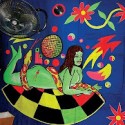Explore Articles Filed Under: Books and Art

Type 2 diabetes has reached epidemic proportions among Native Americans. Complications from diabetes are major causes of death and health problems in almost every Native American community. In the film The Gift of Diabetes, Ojibway filmmaker Brion Whitford uses his own diabetes as a metaphor for his “self-loathing and alienation from my people.” His disease is the physical form of a spiritual condition, a sickness of the soul; and his quest for understanding takes him on a journey back to his own traditions.

We have discussed before the strange ways that the jungle, and in particular the Amazon, has penetrated Western consciousness. Now I have found a new phenomenon to add to the list of odd hybrid cultural artifacts — Amazonia Barbie. Of course, Amazonia Barbie does not look anything like a real Amazonian woman. It is not at all clear that she is intended to. Her ethnicity is a stereotype built up out of fragments of an imagined culture.

Alexander Shulgin — familiarly known as Sasha — is a giant in the field of psychopharmacology, widely loved and admired for his inventiveness, courage, and sense of humor. He was a scrupulous and inventive chemist, and the creator of more than 230 psychoactive substances, most of which he tested on himself and on his wife Ann. For about four years now, Turn of the Century Pictures has been working on a documentary about Shulgin’s life and work. There is reason to believe that the film has evolved over the years. Where is it now?

Jerry Burchfield is a photographer without a camera. Instead, he uses a photographic technique that goes back to the nineteenth-century beginnings of photography — laying materials directly on a black-and-white photosensitive medium, and creating negative images of the shadow cast by sunlight passing through the object. Burchfield calls these lumen or light prints. The results are astonishing.

I continue to observe, with fascination, the slow infiltration of ayahuasca into American popular culture. And now ayahuasca has appeared — much as it did on the show Weeds — on the hugely popular plastic-surgery soap opera Nip/Tuck. The show is engrossing, in much the same way that a slow-motion train wreck is engrossing.

The term poder verde, green power, was first applied to cumbia amazónica — the boisterous sexy ironic kick-ass garage-band party music that first developed in the Upper Amazon during the oil boom of the 1960s. Now there is an equivalent in painting — an exhibition entitled Poder Verde, Visiones Psicotropicales, Green Power: Psychotropical Visions, which brings together the boisterous sexy ironic kick-ass visionary work of contemporary Upper Amazonian painters.

Peyote songs are the prayer music and ceremonial heart of the Native American Church. The songs have traditionally been sung, accompanied by the gourd rattle and water drum, in the various languages and musical styles of the indigenous peoples from which the church drew its membership. At the same time, the pan-Indian nature of the church made it a powerful vehicle for the diffusion of musical styles and content. Early studies of peyote songs, dating from the 1940s, found Navajo peyote singers using the Ute musical style, and recognizably the same peyote song among the Tarahumara, Navajo, and Cheyenne.

We have talked about the Fall 1989 issue of the Whole Earth Review. For aficionados of classic psychedelia, however, there is no substitute for the Psychedelic Review, which was sporadically published from 1963 to 1971, and was excerpted for the book The Psychedelic Reader. The entire run of the journal — eleven issues from 1963 to 1971 — is available online, in PDF format, in the Luminist Archives, and on the website of the Multidisciplinary Association for Psychedelic Studies, where individual articles are also accessible.

An important recent social phenomenon has been the development and expansion of new religious movements in Brazil, which use ayahuasca as a central sacrament within a largely Christian theological and rhetorical context — referring to ayahuasca as the Blood of Christ, for example, or mareación, the ayahuasca experience, as awakening to Christ Consciousness. The Upper Amazonian contribution to these movements was the use of the basic ayahuasca drink, made from the ayahuasca vine and — exclusively — chacruna.

We have talked before about the image of the jungle in the European imagination. Part of that mythology is that the jungle — filled with what German filmmaker Werner Herzog called “fornication and asphyxiation and choking and fighting for survival and growing and just rotting away” — has a mysterious power to drive Europeans crazy.

Discussing the article:
Hallucinogens in Africa